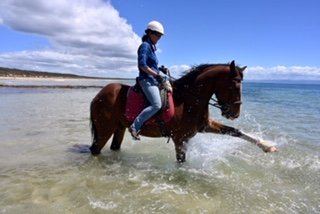
Horses are a well adapted prey animal, their senses have evolved to allow them to know what is going on in a large area around them, so they can be aware of predators and protect themselves. Horses live a group and their senses are adapted to make communication within the group effective.
Sight is an important sense, used to help the horse perceive its environment. Horses have large eyes and excellent vision, an adaptation needed by this prey animal for survival.
The horse’s field of vision is almost 360 degrees. Horses have excellent distance vision but relatively poor accommodation, meaning they cannot focus well or quickly as things change. Visual acuity or clarity of vision is also excellent.
Horses are dichromatic, seeing blues and greens and variations of these colours.
Horses have a greater proportion of rods than cones in their retinas; this gives them great night vision, another adaptation needed by a prey animal, and they see well on overcast conditions. Stereopsis or depth perception is also good.
Horses have a very sensitive muzzle, covered in vibrissae or whiskers with a rich nerve supply. Horses use their muzzle to communicate by touch. They reassure each other with the muzzle and groom each other. This sensitive form of touch helps the horse move and function as a cohesive group. The other very sensitive areas are the elbows, flanks, withers and mouth.
Taste and smell are closely linked. The horse’s sense of smell is highly developed. Their very long nose allows and increased area of nasal mucosa and superior sense of smell. Their sense of taste is also well developed (they taste, sweet, salty, sour and bitter) and can recognise toxic plants and differentiate between young and old grass.
The horse’s sense of smell allows it to distinguish important scents in other horses urine. They even have an extra organ in the back of the nose called the vomero-nasal organ to help with smell.
Horses have a good sense of hearing. Their funnel shaped ears pick up sounds as far as 4.4km away, hearing high-pitched sound better than low-pitched sound. Their ears can swivel 360degrees allowing them to pick up sounds coming in all directions. They can even flatten their ears to block out unwanted sound.